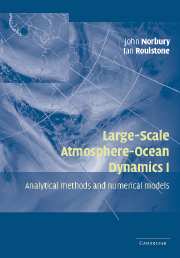Book contents
- Frontmatter
- Contents
- Contributors
- Preface
- Introduction and Scientific Background
- 1 A view of the equations of meteorological dynamics and various approximations
- 2 Extended-geostrophic Euler–Poincaré models for mesoscale oceanographic flow
- 3 Fast singular oscillating limits of stably-stratified 3D Euler and Navier–Stokes equations and ageostrophic wave fronts
- 4 New mathematical developments in atmosphere and ocean dynamics, and their application to computer simulations
- 5 Rearrangements of functions with applications to meteorology and ideal fluid flow
- 6 Statistical methods in atmospheric dynamics: probability metrics and discrepancy measures as a means of defining balance
5 - Rearrangements of functions with applications to meteorology and ideal fluid flow
Published online by Cambridge University Press: 04 February 2010
- Frontmatter
- Contents
- Contributors
- Preface
- Introduction and Scientific Background
- 1 A view of the equations of meteorological dynamics and various approximations
- 2 Extended-geostrophic Euler–Poincaré models for mesoscale oceanographic flow
- 3 Fast singular oscillating limits of stably-stratified 3D Euler and Navier–Stokes equations and ageostrophic wave fronts
- 4 New mathematical developments in atmosphere and ocean dynamics, and their application to computer simulations
- 5 Rearrangements of functions with applications to meteorology and ideal fluid flow
- 6 Statistical methods in atmospheric dynamics: probability metrics and discrepancy measures as a means of defining balance
Summary
Introduction
This article studies rearrangements of functions, and considers applications to ideal fluid flow, decomposition of weather forecast error, and a system of equations which models large scale atmospheric and oceanic flow. We begin by giving an intuitive idea of when a function is a rearrangement of another function. Let f be a function defined on a bounded set, and imagine that Ω is a continuum of infinitesimal particles. Suppose we exchange the particle positions, with each particle retaining its value of f. This yields a function g, which is a rearrangement of f. This intuitive notion makes sense whether we attach a scalar or a vector to a particle: the idea of rearranging a function can be applied to both scalar and vector valued functions. Roughly speaking, the formal definition of two functions f and g being rearrangements is that for any given set of values, the set where f takes those values has the same size as the corresponding set for g. (We give precise definitions in §2 and §5.)
For a prescribed function f0, we can consider the set of all rearrangements of f0. Sets of rearrangements of some given function arise naturally in applications in the following ways:
(i) Suppose we have a quantity q which is conserved following the flow in an ideal (i.e. incompressible, inviscid) fluid. If we consider a fluid particle, it may move as the fluid evolves, but it retains the same value of q, and the particle does not change size (as the flow is incompressible). It follows that at any two instants of time t1 and t2, q(t1) and q(t2) are rearrangements.(Compare with the intuitive notion of rearrangement above.) In particular, at any time t, q(t) belongs to the set of rearrangements of q(0).
[…]
- Type
- Chapter
- Information
- Large-Scale Atmosphere-Ocean DynamicsAnalytical Methods and Numerical Models, pp. 288 - 341Publisher: Cambridge University PressPrint publication year: 2002
- 1
- Cited by



